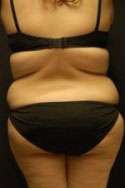Challenging Tummy Tuck Patient 5’7″ 243 lbs after Vaser Liposuction and TT
Ten weeks post-op.
The goal for this patient was to give her as good a result as possible despite being overweight. Vaser ultrasonic liposuction first removed four lbs. of fat from her flanks, waist and upper abdomen. Bra rolls and hips were not done, but the area over the ribs below the breast was treated.
The weight of the overhanging skin and fat removed was 9 lbs. After elevation of the flap, further refinement by thinning the flap from below was done. The rectus muscle repair was done in three layers, the first being permanent individual figure-of-eight followed by a running double row of long-lasting Quill sutures to further tighten and adjust the tension. Sutures were placed from the hole made to receive the belly button down to the abdominal wall to pull the scar into the recess and make it less visible. The flap was re-attached to the abdominal wall with progressive tension and quilting sutures that closed off the space and eliminated the need for drains. Exparel long-acting bupivacaine anesthetic was injected throughout the abdomen and flanks both subcutaneously and subfascially. The patient woke up without any pain and needed only Tylenol over the next three days. The closure of the flap was done in four layers for a secure tension-relieving closure to give her the best chance of minimal scar healing.
The pre-op mons is not shown, but was significantly ptotic (droopy) and bulky. It was reduced by direct wedge excision, reduction in height and suspension to the abdominal wall. The esthetic treatment of the mons is a an essential component of abdominoplasty but is often under-treated or neglected.
Some improvement in posture with decreased lumbar curve or lordosis can be appreciated. Patients with low back pain often note that their pain is decreased after the muscle repair of a tummy tuck has tightened their core.









